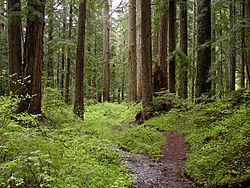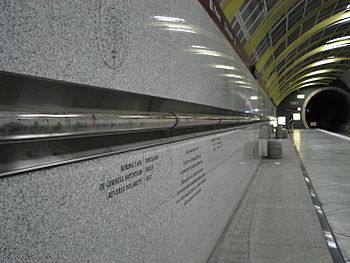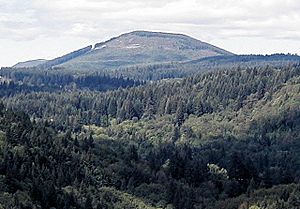Boring Lava Field facts for kids
Quick facts for kids Boring Lava Field |
|
|---|---|

Mount Sylvania, one of the major volcanoes in the Boring Lava Field in Portland, Oregon
|
|
| Location | Oregon and Washington, U.S. |
| Coordinates | 45°18′N 122°30′W / 45.3°N 122.5°W |
| Highest point – elevation – coordinates |
Larch Mountain 4,061 feet (1,238 m) 45°18′N 122°30′W / 45.3°N 122.5°W |
| Geology | Volcanic field |
| Age | Pleistocene |
| Last eruption | ≈57,000 years ago |
The Boring Lava Field is a special area in Oregon and Washington with many small volcanoes. It has cinder cones (cone-shaped hills made of volcanic rock), small shield volcanoes (volcanoes with gentle slopes), and lava flows (rivers of molten rock). This area gets its name from the town of Boring, Oregon, which is about 12 miles (19 km) southeast of Portland.
The volcanoes in this field started forming about 2.7 million years ago. They had long periods of activity, then rested, and then became active again. The last eruptions happened about 57,000 years ago at a volcano called Beacon Rock. Even though the individual volcanoes are considered extinct (meaning they won't erupt again), the entire field itself is not. This means new volcanoes could still form there someday, though it's very unlikely.
The Boring Lava Field covers a huge area of about 1,500 square miles (3,885 km²). It's home to many different plants and animals. The tallest point in the field is Larch Mountain, which is about 4,055 feet (1,236 meters) high. The Portland area is one of the few places in the U.S. that has extinct volcanoes right inside the city! The Boring Lava Field is important for local things like building tunnels and creating parks. While a future eruption would be dangerous, experts say the chance of it happening is very low.
Contents
What is the Boring Lava Field?
The Boring Lava Field is named after the town of Boring. This town is about 12 miles (19 km) southeast of downtown Portland. The term "Boring Lava" is used for the rocks that came out of these volcanoes. Scientists first named these rocks in 1942. Later, in 2002, they realized that all these similar rocks and volcanoes were part of one big area, which they called the Boring Lava Field.
The highest point in the field is Larch Mountain, which is about 4,055 feet (1,236 meters) tall. Most of the other volcanoes are smaller, around 650 feet (200 meters) above the land around them. The field has more than 80 small volcanoes and lava flows. Some volcanic rocks might even be hidden under layers of dirt and other rocks. The Boring Lava Field covers about 1,500 square miles (3,885 km²).
How does the landscape look?
The land around Portland is very varied. It goes from flat river valleys to hills that are over 1,000 feet (300 meters) high. The Columbia River flows through this area, and it has really shaped the land over time. Many smaller rivers and streams also flow into the Columbia and Willamette rivers.
One of these streams, Multnomah Creek, flows from Larch Mountain. Water from the ground, called groundwater, also flows into local streams. This groundwater comes from a large underground water source called an aquifer. The Boring Lava rocks can affect how this groundwater moves.
Portland has a mild climate. It has long growing seasons for plants, with moderate rain, mild winters, and warm, dry summers. It usually doesn't get very cold, with over 200 days a year without frost. Temperatures can change a lot, but usually, summers are not too hot, and winters are not too cold. Most of the rain falls between October and March. The wind usually blows from the south in winter and from the northwest in summer.
What plants and animals live there?
The mild climate and rain in Portland allow many plants to grow. In the past, many forests were cut down for farming or wood. Now, these areas have new forests growing back. You can find plants like huckleberry, poison oak, and blackberry. There are also many types of ferns and fast-growing trees like alder and vine maple.
Older forests have tall trees like Douglas fir, western hemlock, and western redcedar. In wet areas, you might see a shrub called Devil's club. Other common trees include black cottonwood and red alder. Many different shrubs and ground plants also grow here.
Today, about half of the Boring Lava region is still forested. But as more houses are built, forests are cleared. This can make water quality worse and cause more flooding. The streams in the area are cool and clear. They are home to many small water creatures, and some even have amphibians and fish. The areas along the rivers and streams are important for birds, mammals, reptiles, and amphibians to move around.
The United States Fish and Wildlife Service has listed several "sensitive" species in the Boring Lava area. These are plants and animals that might be at risk. For plants, some examples are the white top aster and golden Indian paintbrush. For animals, some examples include northwestern pond turtles, Willow flycatchers, and northern red-legged frogs. Important birds like pileated woodpeckers and bald eagles, and fish like cutthroat trout and coho salmon, are also considered sensitive.
How has the area been used by people?
The Portland area has been a trading center since it was founded in 1845. Over time, different industries grew. People used to mine iron and make paper. Now, there are also factories that make cement and aluminum. Many of these industries use resources from other places, but the paper industry uses local wood.
In 1893, Kelly Butte Natural Area was created. This park is about 6 miles (10 km) southeast of downtown Portland and includes part of the Boring Lava Field. In the past, there was a quarry (a place where rocks are dug out) there. Prisoners used to work in the quarry, crushing rocks for roads in Portland. Rocks from the Boring Lava Field have been used to build walls and rock gardens. Today, there is no mining happening near the Boring Lava Field.
In 1952, a special center was built at Kelly Butte. It was meant to be a safe place for local government leaders if a nuclear attack happened. It was a model for other cities. Later, it became an emergency dispatch center. Today, Kelly Butte is a park for people to enjoy.
In 1981, Portland built a water reservoir at Powell Butte, which is also part of the Boring Lava Field. This reservoir still provides water to the city. In 1987, Powell Butte Nature Park was created. It's a large park with meadows and forests. A new underground reservoir was built there between 2011 and 2014. This new reservoir led to improvements in the park, like better trails and a visitor center.
The Robertson Tunnel, built between 1993 and 1998, goes through the Tualatin Mountains. It's about 80 meters (260 feet) underground and is the deepest train station in North America. Inside the tunnel, you can see layers of rock, including deposits from the Boring Lava Field. These layers show how the land has changed over millions of years.
In 2000, a group called Friends of Mt. Tabor Park was formed to help take care of Mount Tabor Park. This park is about 3.5 miles (5.6 km) east of downtown Portland. They help maintain the park and publish a newsletter.
In 2017, Hogan Butte Nature Park opened in Gresham. This park includes Hogan Butte, which is an extinct volcano from the Boring Lava Field. Gresham is another city in the U.S. that has volcanoes within its city limits. Other volcanoes like Mount Sylvania and Mount Scott are in Portland.
How did the volcanoes form?

There are about 90 volcanoes in the Boring Lava Field. Most of them are small cinder cones, but some are larger lava domes from shield volcanoes, like Mount Sylvania and Larch Mountain. The Boring Lava Field has the most volcanoes in this area, with over 80 known small volcanoes and lava flows. Many more might be buried under layers of rock from ancient floods.
The Boring Lava Field is considered an "outlier" of the Cascade Range (a chain of volcanoes). It's about 60 miles (100 km) west of the main Cascade mountains. Like the Cascade Range, the Boring field formed because the Juan de Fuca Plate (an ocean plate) is sliding under the North American tectonic plate (the land plate). This process is called subduction. However, the Boring Lava Field is a bit different. Its eruptions are more likely linked to the land stretching and cracking in the region.
The rocks from the Boring Lava Field are similar to those found in the High Cascades. They are mostly basalt (a common type of volcanic rock) and andesite (another type of volcanic rock). The lava flows often have columnar (like tall columns) and platy (like flat plates) shapes. These can be seen in Oregon and Washington.
Sometimes, where Boring Lava sits on top of older rock layers, landslides can happen. This is because Portland's wet climate causes the rocks to weather (break down) over time. This creates a red, clay-like soil.
What are the main volcanoes in the field?
Scientists have identified many volcanic centers in the Boring Lava Field. One expert, J. E. Allen, found 95 volcanoes in 1975 and grouped them into four areas. Many of these volcanoes are unnamed, and some have more than one vent (opening where lava comes out).
Most of the volcanoes in the eastern part of the field are less than 1.6 miles (2.6 km) wide and less than 1,090 feet (332 meters) tall. The lava flows from large shield volcanoes like Highland Butte and Larch Mountain cover a wide area. Most of the top craters of these volcanoes have been destroyed, but some still have partial craters, like Battleground Lake and Mount Scott. Many of the Boring cones still look like volcanic cones.
Famous volcanoes in the area include Rocky Butte, which is about 330 feet (100 meters) tall, and Mount Tabor, which is about 203,000 years old. Other well-known ones are Kelly Butte, Powell Butte, and Mount Scott.
There are also lava tubes (underground tunnels formed by flowing lava) near the Catlin Gabel School. These are the oldest known lava tubes in Oregon. They formed when lava cooled on the surface, but the hot lava inside kept flowing, creating tunnels. These tubes are very old and are mostly hidden underground.
Volcanoes in Oregon
Here are some of the volcanoes in Oregon:
| Name | Elevation | Other Notes |
|---|---|---|
| Chamberlain Hill | 890 feet (271 m) | |
| Cook's Butte | 718 feet (219 m) | |
| Highland Butte | 1,594 feet (486 m) | |
| Kelly Butte | 400 feet (122 m) | |
| Larch Mountain | 4,061 feet (1,238 m) | |
| Powell Butte | 614 feet (187 m) | |
| Rocky Butte | 612 feet (187 m) | |
| Ross Mountain | 1,380 feet (421 m) | |
| Swede Hill | 995 feet (303 m) | |
| Mount Scott | 1,093 feet (333 m) | Named for Harvey W. Scott |
| Mount Sylvania | 978 feet (298 m) | |
| Mount Tabor | 630 feet (192 m) | |
| Mount Talbert | 715 feet (218 m) | |
| TV Hill | 1,275 feet (389 m) | |
| Walker Peak | 2,450 feet (747 m) |
Volcanoes in Washington
Here are some of the volcanoes in Washington:
| Name | Elevation | Other Notes |
|---|---|---|
| Battle Ground Lake | 509 feet (155 m) | |
| Bob's Mountain | 2,110 feet (643 m) | |
| Bob's Mountain (N) | 1,775 feet (541 m) | |
| Bob's Mountain (S) | 1,690 feet (515 m) | |
| Brunner Hill | 680 feet (207 m) | 2 vents |
| Green Mountain | 804 feet (245 m) | |
| Mount Norway | 1,111 feet (339 m) | |
| Mount Pleasant | 1,010 feet (308 m) | |
| Mount Zion | 1,465 feet (447 m) | |
| Nichol's Hill | 1,113 feet (339 m) | |
| Pohl's Hill | 1,395 feet (425 m) | |
| Prune Hill (E) | 610 feet (186 m) | |
| Prune Hill (W) | 555 feet (169 m) | |
| Tum-Tum Mountain | 1,400 feet (427 m) |
When did the volcanoes erupt?
Volcanoes in the Boring Lava Field often erupted in groups of three to six vents, like at Bobs Mountain. These groups usually produced similar types of lava in short periods. Most eruptions created basalt and basaltic andesite lava. Some, like the large Larch Mountain volcano, also produced andesite.
Scientists have learned a lot about the field's history recently. Eruptions started between 2.6 and 2.4 million years ago. These early eruptions created large basalt lava flows and the Highland Butte shield volcano. Then, the volcanoes were quiet for about 750,000 years.
Around 1.6 million years ago, eruptions started again further north. These created the Mount Scott shield volcano. Over time, the eruptions moved east, forming the Larch Mountain volcano. Activity spread across the whole area about 1 million years ago, and the types of lava became more varied. This period lasted until about 500,000 years ago. After another quiet period, eruptions continued from about 350,000 years ago until roughly 50,000 to 60,000 years ago.
The youngest known eruptions in the Boring area happened about 105,000 years ago. Generally, the younger volcanoes are in the northern part of the field, and the older ones are in the south. Most of these eruptions were just lava flowing out. Only a few eruptions were explosive, sending out ash and rock fragments.
Are there any current threats?
The last volcano to form in the field was Beacon Rock, about 57,000 years ago. While the individual volcanoes in the Boring Lava Field are considered extinct, the field itself is not. This means it could still erupt again. However, the United States Geological Survey (USGS) says the chance of a future eruption in the Portland–Vancouver area is "very low."
It's rare for more than 50,000 years to pass without an eruption in this region. Based on past activity, an eruption is expected to happen about once every 15,000 years on average.
About half of the past eruptions happened in areas that are now heavily populated. If a small volcano formed, it might not spread far. But it could still cover large areas with volcanic ash, causing problems for buildings and roads. A larger eruption, like the ones that built Larch Mountain or Mount Sylvania, could last for years. Scientists are not sure exactly where a future eruption might happen, but it would probably be in the northern part of the field.
Some earthquake faults in the area were formed by the Boring Lava. So, the Boring Lava might affect how much the ground shakes during future earthquakes.
Fun things to do
The city of Gresham has trails that go over parts of the Boring Lava Field and its volcanoes. Mount Tabor and Powell Butte are popular places for outdoor activities. Powell Butte Nature Park has about 9 miles (14 km) of trails. Mount Tabor Park is open for walking and biking from 5 a.m. to midnight. Cars can drive there from 5 a.m. to 10 p.m., except on Wednesdays when the roads are closed to cars.
Hogan Butte Nature Park offers amazing views of Mount Adams, Mount Hood, Mount Rainier, and Mount St. Helens. It also has running trails and places for picnics. The mayor of Gresham once said the park would "quickly become Gresham's crown jewel."
Besides Hogan Butte, some smaller volcanoes are also open to the public. The Gresham Saddle Trail goes over Gresham Butte and Gabbert Butte. This trail is about 3.3 to 3.7 miles (5.3 to 6 km) long and is considered moderately difficult. It goes through forests with maples, alders, ferns, and firs.
Images for kids




